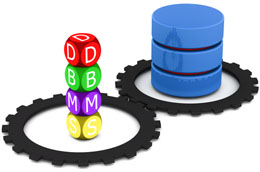Organizations produce and gather data as they operate. Contained in a database, data is typically organized to model relevant aspects of reality in a way that supports processes requiring this information. Knowing how this can be managed effectively is vital to any organization.
What is a Database Management System (or DBMS)?

Organizations employ Database Management Systems (or DBMS) to help them effectively manage their data and derive relevant information out of it. A DBMS is a technology tool that directly supports efficient data management. It is a package designed to define, manipulate, and manage data in a database.
Some general functions of a DBMS:
- Designed to allow the definition, creation, querying, update, and administration of databases
- Define rules to validate the data and relieve users of framing programs for data maintenance
- Convert an existing database, or archive a large and growing one
- Run business applications, which perform the tasks of managing business processes, interacting with end-users and other applications, to capture and analyze data
Some well-known DBMSs are Microsoft SQL Server, Microsoft Access, Oracle, SAP, and others.
Components of DBMS
DBMS have several components, each performing very significant tasks in the database management system environment. Below is a list of components within the database and its environment.
Software
This is the set of programs used to control and manage the overall database. This includes the DBMS software itself, the Operating System, the network software being used to share the data among users, and the application programs used to access data in the DBMS.
Hardware
Consists of a set of physical electronic devices such as computers, I/O devices, storage devices, etc., this provides the interface between computers and the real world systems.
Data
DBMS exists to collect, store, process and access data, the most important component. The database contains both the actual or operational data and the metadata.
Procedures
These are the instructions and rules that assist on how to use the DBMS, and in designing and running the database, using documented procedures, to guide the users that operate and manage it.
Database Access Language
This is used to access the data to and from the database, to enter new data, update existing data, or retrieve required data from databases. The user writes a set of appropriate commands in a database access language, submits these to the DBMS, which then processes the data and generates and displays a set of results into a user readable form.
Query Processor
This transforms the user queries into a series of low level instructions. This reads the online user’s query and translates it into an efficient series of operations in a form capable of being sent to the run time data manager for execution.
Run Time Database Manager
Sometimes referred to as the database control system, this is the central software component of the DBMS that interfaces with user-submitted application programs and queries, and handles database access at run time. Its function is to convert operations in user’s queries. It provides control to maintain the consistency, integrity and security of the data.
Data Manager
Also called the cache manger, this is responsible for handling of data in the database, providing a recovery to the system that allows it to recover the data after a failure.
Database Engine
The core service for storing, processing, and securing data, this provides controlled access and rapid transaction processing to address the requirements of the most demanding data consuming applications. It is often used to create relational databases for online transaction processing or online analytical data processing.
Data Dictionary
This is a reserved space within a database used to store information about the database itself. A data dictionary is a set of read-only table and views, containing the different information about the data used in the enterprise to ensure that database representation of the data follow one standard as defined in the dictionary.
Report Writer
Also referred to as the report generator, it is a program that extracts information from one or more files and presents the information in a specified format. Most report writers allow the user to select records that meet certain conditions and to display selected fields in rows and columns, or also format the data into different charts.
Applications of Database Management Systems
An estimated 2.5 quintillion bytes of data are generated each day. This exponential growth in generated data has enhanced the need to integrate DBMS in almost every aspect of daily life.
Important sectors where DBMS finds application include:
- Reservation Systems
Planning travel and making reservations for trains and flights are simplified with DBMS. DBMS applications help manage the schedule and track delays, boarding, and departure of flights or trains.
- Online Shopping
With the accelerated growth of the eCommerce sector, web-based shopping has increased on platforms such as Amazon, eBay, Walmart, etc. Data management systems store and track all the important information related to the orders, such as invoices, shipping details, refund status, etc.
- Healthcare System
DBMSs are of critical importance in the healthcare system as they help organize, track and extract patient information such as appointments, treatment records, payments, doctor schedules, invoices, etc.
- Finance Sector
In addition to its immense application in banking, DBMS is important in storing and managing accounting and finance-related information such as sales reports, financial statements, financial assets, stocks, bonds, etc.
- HR Management System
Database management systems help HR executives store and manage employee information such as name, designation, salary, tax, insurance details, etc.
- Scientific Database
Researchers utilize DBMS to store scientific research data, track projects, conduct comparative studies, develop experiment protocols, and more.
Great Performance through Effective DBMS
A company’s performance is greatly affected by how it manages its data. And one of the most basic tasks of data management is the effective management of its database. Understanding the different components of the DBMS and how it works and relates to each other is the first step to employing an effective DBMS.
Data Entry Outsourced (DEO) applies globally recognized industry innovation across professional data entry services, techniques, and practices to help businesses with data management, data extraction, and data analytics. Our data entry, data conversion, and data processing services are backed by years of experience skill.
– Data Czar @ DEO




